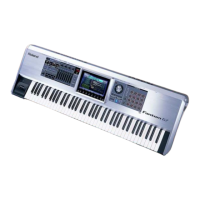6
PRST 001:System G
PRST 001: System G, the first preset live set, does more than just show off
the great sound of the Fantom-G—it also shows you how you can split and
layer patches in a live set. (If System G isn’t already selected, use the previous
steps to select it now.)
Play some notes below Middle C with your left hand—you hear a throbbing,
complex groove that plays at the pitch of the note whose key you press. Now
play some notes above Middle C with your right hand to hear a classic brass-
synth sound with an unusually interesting trail-off. As you play the keyboard,
you can see the notes you play light up onscreen in pink.
Split Personalities
Each of the patches in System G is set to play only from a specific range of
keys. Parts 1-6’s patches (in the blue square below) play only below Middle C
as you can see onscreen when you play up and down the keyboard.
Parts 1-6
The patches played by Parts 7 and 8—in red in the following illustration—
play only from Middle C up.
Parts 7 and 8
This is called a “split” because the keyboard is split into two keyboard ranges
that play different sounds. You can split a keyboard in a live set into as many
as eight ranges with internal sounds, and more with ARX and MIDI sounds.
You can see the name of the patch each part plays in the part list’s
Patch Number/Name column. You can also see that each of the parts’
sounds is a patch, as shown in the Type column.
Layer Cake
You also see that the lower range of the keyboard plays six parts at once,
and the upper range plays two. When sounds play together, they’re “layered.”
Layering is a great way to create complex, interesting, sounds. System G
demonstrates what we mean:
under your left hand—
• you’ve got an extremely complicated rhythmic
texture created by six patches layered on top of each other.
• under your right hand—you’ve got simple synth brass notes that slowly
morph into a pretty burbly sample-and-hold sound that results from
layering the 80s Brass 3 (the synth) and Cross Talk (the burble) patches.
You can see that all of these patches are turned
on by looking at their lit KBD (for “keyboard”)
switches.

